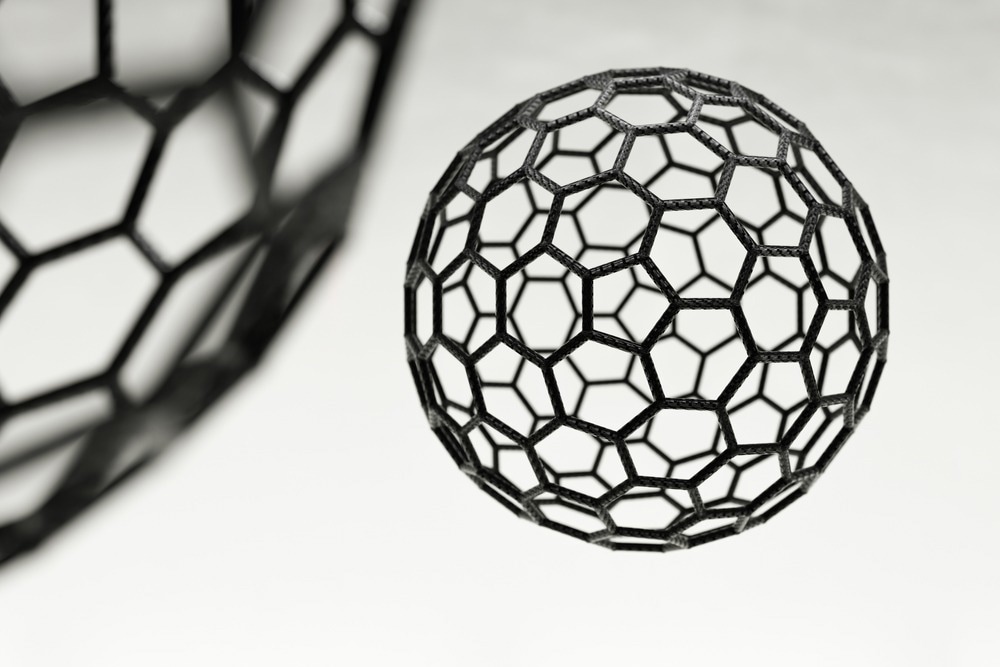Enzyme mimics based on self-assembling nanomaterials are an easy way to replicate the activities of natural enzymes. However, these enzyme mimicking nanomaterials were not used to understand the influence of amino acids on the catalytic activity.

Study: Self-Assembled Fullerene Nanostructures for Mimicking and Understanding of Natural Enzyme. Image Credit: Forance/Shutterstock.com
An article published in the journal ACS Applied Nano Materials presented catalytically active amino acid- functionalized fullerene nanostructures with multiple active sites formed during the self-assembly process in an aqueous environment.
These functionalized nanostructures served as an effective system that distinguished the differences in the catalytic activity that resulted from single amino acid changes. Here, a nano-level tuning of intramolecular and intermolecular interactions resulted in the formation of efficient enzyme mimics.
Additionally, different enzyme classes were mimicked, including hydrolases and lyases, with high catalytic activity by exploiting the carboxyl-imidazole couple as the primary catalytic unit. Like natural enzymes, the engineered nanocatalysts were also reusable and catalytically active in physiological settings.
Natural Enzymes and Fullerene
Enzyme mimicry is a topic of interest in developing multifunctional biomimetic materials. Mimicking the activity of natural enzymes is the primary challenge in biomaterials research, and artificial analogs that simultaneously recapitulate the catalytic and metabolic activity of natural enzymes are the goal of this field.
Natural enzymes are evolutionarily perfected catalysts that accelerate the reaction rates with extreme substrate specificity. Due to their outstanding catalytic activity, natural enzymes have been the subject of intense study to understand their action mechanisms and mimic their catalytic activity based on the obtained knowledge.
The three-dimensional (3D) structure of natural enzymes greatly influences their catalytic activity and can locate catalytic residues precisely into optimum positions to facilitate catalysis. While the precise location is crucial for enzymatic catalysis, aligning catalytic units to realize the suitable molecular locations and distances is challenging in simpler enzyme mimic designs.
Since the discovery of buckminsterfullerene (C60) in 1985, fullerene has been widely studied due to its unique structural, electronic, and spectroscopic properties that could be exploited for their diverse applications in multidisciplinary studies.
Fullerenes are a promising family of electroactive compounds with a few unique characteristics that make this new type of compound very promising as mediators in amperometric biosensors. The fullerene-mediated system maintains good overall analytical characteristics over the unmediated ones, often allowing the resulting electrochemical biosensors to operate at lower potentials, thus reducing the interferences from electroactive compounds.
Fullerene Nanostructures for Mimicking Natural Enzymes
Previous research has shown that amino acid-functionalized fullerene nanostructures function as self-assembling nanocatalysts, accumulating many random active sites. The effectiveness of the fullerene nanocatalysts was attributed to their icosahedral symmetry, which enabled the regular presentation of active sites and large functional surfaces because of their nanoscale size.
In the present study, amino acid-functionalized fullerene nanostructures were used as an effective nanocatalyst platform to comprehend and mimic different catalytic actions. Based on the naturally existing aspartate-histidine-serine catalytic triad, histidine was selected as the central catalytic unit and functionalized with an amino group that can regularly present active sites, and thus functionalized nanoplatform showed outstanding bio-catalytic activity.
The addition of aspartate to the nanoplatform provided the system access to the functional unit of the -carboxyl group and served as a polarizer for the imidazole ring of histidine. Free-carboxyl-bearing histidines formed the charge of the carboxyl-imidazole unit relay system on the fullerene. Several natural enzymes, including chymotrypsinogen A, have these systems to promote nucleophilic attack via the activation of hydroxyl molecules.
In addition to histidine, as a side group of our nanocatalysts, additional amino acids with unique chemical properties were added. Due to the amino groups, including arginine, and glutamine amino acids, transition-state intermediates can be electrostatically stabilized.
However, as an electrostatic stabilizer, arginine is far more common than glutamine in enzyme-active areas. The hydroxyl groups of the remaining three amino acids, serine, threonine, and tyrosine, can function as nucleophiles when activated by the carboxyl-imidazole couple.
Conclusion
To conclude, histidine and side amino acid-decorated fullerene-based nanocatalysts exhibited significant biocatalytic activity for hydrolysis of different ester substrates and hydration of carbon dioxide (CO2), indicating the versatility of the system towards different enzyme-catalyzed reactions.
These functionalized fullerene nanostructures could mimic the activities of natural enzymes in biological systems. Due to the versatility of the current platform, it can be used in different enzyme-mimicking systems with diverse catalytic units.
In addition, this might be a novel practical nanobiotechnology strategy to research site-directed mutagenesis, since the impact of various functional groups on catalytic performance can be studied. Thus, fullerene nanocatalysts were presented as a powerful platform for mimicking and understanding the evolution of natural enzymes because of their demonstrated catalytic activity, outperforming some of the most promising enzyme mimics reported in the literature.
Reference
Demirsoy, Zeynep., Gulseren, G. (2022) Self-Assembled Fullerene Nanostructures for Mimicking and Understanding of Natural Enzymes. ACS Applied Nano Materials. https://pubs.acs.org/doi/10.1021/acsanm.2c02194
Disclaimer: The views expressed here are those of the author expressed in their private capacity and do not necessarily represent the views of AZoM.com Limited T/A AZoNetwork the owner and operator of this website. This disclaimer forms part of the Terms and conditions of use of this website.